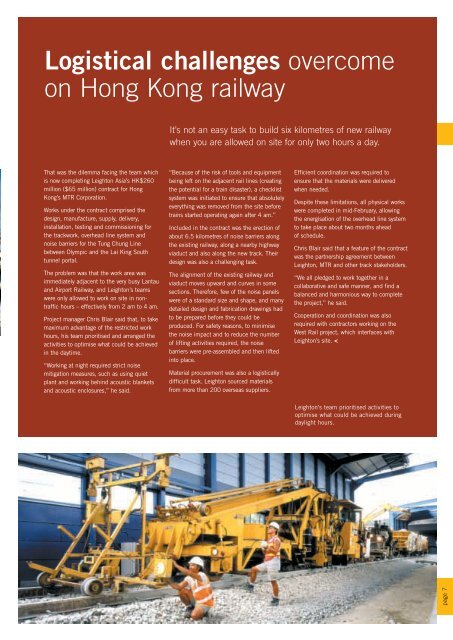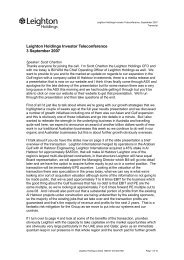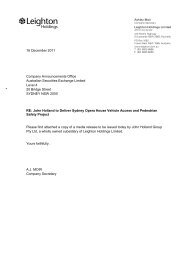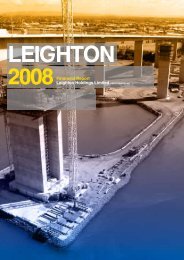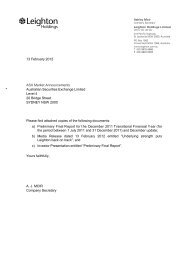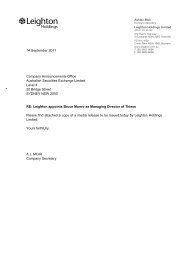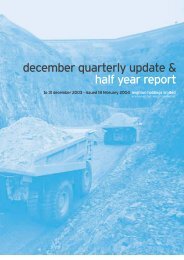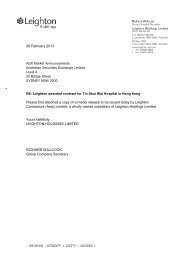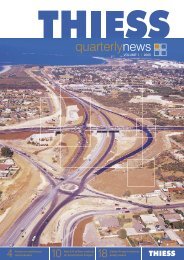Leighton News - Leighton Holdings
Leighton News - Leighton Holdings
Leighton News - Leighton Holdings
You also want an ePaper? Increase the reach of your titles
YUMPU automatically turns print PDFs into web optimized ePapers that Google loves.
Logistical challenges overcome<br />
on Hong Kong railway<br />
It’s not an easy task to build six kilometres of new railway<br />
when you are allowed on site for only two hours a day.<br />
That was the dilemma facing the team which<br />
is now completing <strong>Leighton</strong> Asia’s HK$260<br />
million ($65 million) contract for Hong<br />
Kong’s MTR Corporation.<br />
Works under the contract comprised the<br />
design, manufacture, supply, delivery,<br />
installation, testing and commissioning for<br />
the trackwork, overhead line system and<br />
noise barriers for the Tung Chung Line<br />
between Olympic and the Lai King South<br />
tunnel portal.<br />
The problem was that the work area was<br />
immediately adjacent to the very busy Lantau<br />
and Airport Railway, and <strong>Leighton</strong>’s teams<br />
were only allowed to work on site in nontraffic<br />
hours – effectively from 2 am to 4 am.<br />
Project manager Chris Blair said that, to take<br />
maximum advantage of the restricted work<br />
hours, his team prioritised and arranged the<br />
activities to optimise what could be achieved<br />
in the daytime.<br />
“Working at night required strict noise<br />
mitigation measures, such as using quiet<br />
plant and working behind acoustic blankets<br />
and acoustic enclosures,” he said.<br />
“Because of the risk of tools and equipment<br />
being left on the adjacent rail lines (creating<br />
the potential for a train disaster), a checklist<br />
system was initiated to ensure that absolutely<br />
everything was removed from the site before<br />
trains started operating again after 4 am.”<br />
Included in the contract was the erection of<br />
about 6.5 kilometres of noise barriers along<br />
the existing railway, along a nearby highway<br />
viaduct and also along the new track. Their<br />
design was also a challenging task.<br />
The alignment of the existing railway and<br />
viaduct moves upward and curves in some<br />
sections. Therefore, few of the noise panels<br />
were of a standard size and shape, and many<br />
detailed design and fabrication drawings had<br />
to be prepared before they could be<br />
produced. For safety reasons, to minimise<br />
the noise impact and to reduce the number<br />
of lifting activities required, the noise<br />
barriers were pre-assembled and then lifted<br />
into place.<br />
Material procurement was also a logistically<br />
difficult task. <strong>Leighton</strong> sourced materials<br />
from more than 200 overseas suppliers.<br />
Efficient coordination was required to<br />
ensure that the materials were delivered<br />
when needed.<br />
Despite these limitations, all physical works<br />
were completed in mid-February, allowing<br />
the energisation of the overhead line system<br />
to take place about two months ahead<br />
of schedule.<br />
Chris Blair said that a feature of the contract<br />
was the partnership agreement between<br />
<strong>Leighton</strong>, MTR and other track stakeholders.<br />
“We all pledged to work together in a<br />
collaborative and safe manner, and find a<br />
balanced and harmonious way to complete<br />
the project,” he said.<br />
Cooperation and coordination was also<br />
required with contractors working on the<br />
West Rail project, which interfaces with<br />
<strong>Leighton</strong>’s site. <<br />
<strong>Leighton</strong>’s team prioritised activities to<br />
optimise what could be achieved during<br />
daylight hours.<br />
page 7


